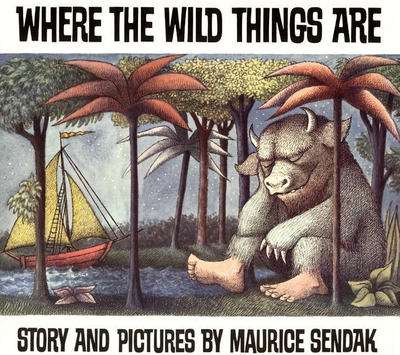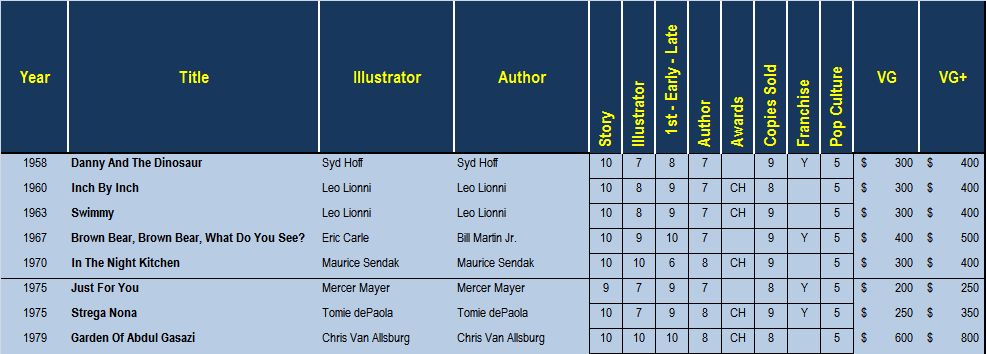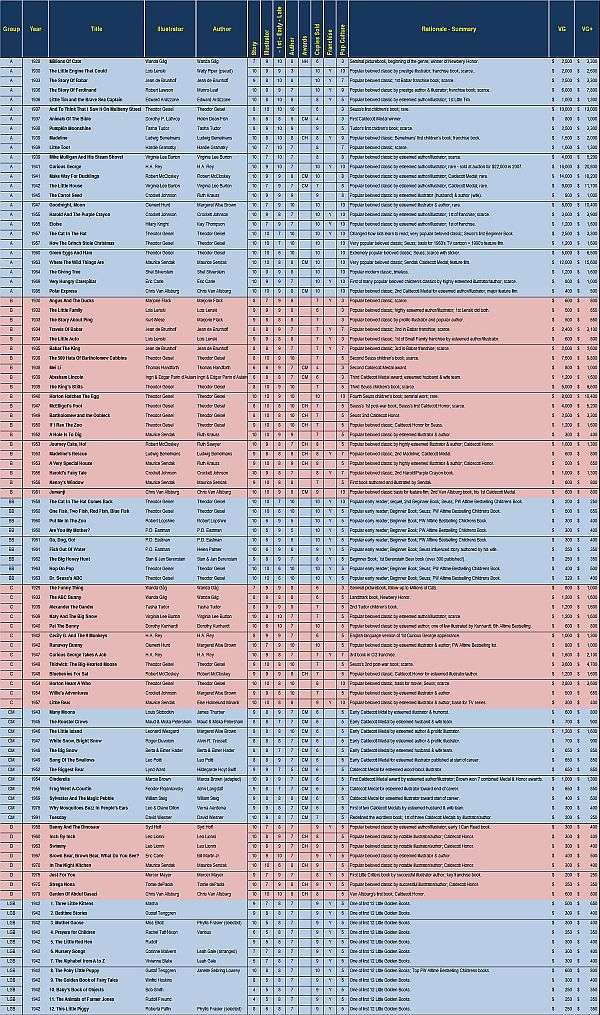Top 100 Picturebooks - Late Great Debatable Eight
Top 100 Collectible Picturebooks - Overview
A series of articles to select the Top 100 Collectible
Children’s Picturebooks, providing the rationale for each book’s inclusion, with an objective of providing readers with the context
for valuing first editions within the genre.
Within the hobby value is a combination of scarcity and collectibility: very scarce and very desirable lead to very valuable. Scarcity is a
function of the number of copies in the first printings and the subsequent attrition over time due to natural causes. Collectibility is more
elusive, outlined heretofore as a complex intermingling of eight rated factors.
The Late Great Debatable Eight
In the previous articles I've selected ninety-two of the Top 100 Collectible American Picturebooks. Today, the last eight books are selected. As expected, there has been a lot of internal strife concerning each of the eight, what with so many other books to select from, therefore this group of books is affectionately referred to as the Late Great Debatable Eight.
The following chart provides a single line summary of the rationale for the book's selection, along with the estimated market price. The market price is for the first edition book with the corresponding first edition dust jacket, both in Very Good or VG+ condition. The list is sorted in chronological order.

The value of several of the 'Late Great Debatable Eight' is higher than many of the books previously selected. To reiterate, value was not the penultimate attribute for a book's inclusion in the Top 100 Collectible American Picturebooks.
 Since the selection of each of these was so contentious, I'll provide some commentary on each book:
Since the selection of each of these was so contentious, I'll provide some commentary on each book:
- Danny And The Dinosaur (1958) is one of Harper & Brothers first books in the 'I Can Read' series, published a year after the Sendak/Minarik's Little Bear. Syd Hoff wrote and illustrated a number of the early 'I Can Read' books, including Julius (1959), Sammy The Seal (1959), Oliver (1960), Stanley (1960), Albert The Albatross (1961), Chester The Horse (1961), and Little Chief (1961), each of which was published prior to Harper & Brothers 1962 merger with Peterson & Row (becoming Harper & Row). I think these early I Can Read books are under appreciated by the hobby.
- Inch By Inch (1960) and Swimmy (1963) each won Leo Lionni a Caldecott Honor award. I debated between each of these and ground breaking illustrations in Lionni's first children book, Little Blue and Little Yellow (1959), but thought the Caldecott tilted the scale toward the award books. Lionni had a very successful career as a commercial illustrator, eventually becoming art director for Fortune magazines, and influencing the art direction of many other Time/Life magazines. He left the commercial art field and became solely a children's book author and illustrator, earning four Caldecott Honor awards. Swimmy would likely have won the Caldecott Medal in almost any other year, however had the misfortune of being published in the same year as Sendak's Where The Wild Things Are.
- Brown Bear, Brown Bear What Do You See? (1968) is the first children's picturebook illustrated by Eric Carle, and similar to Lionni's, the illustrations were ground breaking; even today, the illustrations seem fresh. His Very Hungry Caterpillar, which made the Marquis 25, was published the following year in 1969.
- Maurice Sendak's In The Night Kitchen (1970) won a Caldecott Honor award.
- Some readers might be surprised by the selection of Mercer Mayer's Just For You (1975). The book introduces the Little Critter character, and the franchise has grown to over 200 books strong! A couple of animated cartoons have been produced, and it seems only a matter of time before a TV series or movie is made. While the vast majority of Little Critter books are published only in soft cover format, Just For You was one of the few published initially in hard cover with dust jacket. The first edition is currently very affordable and moderately available, as it is not front-of-mind for many booksellers.
- Even though Tomie dePaola's Strega Nona (1975) won a Caldecott Honor, it is better known by mothers of book readers than book collectors. DePaola has written and illustrated over 200 children's books, and won a Newbery Honor in 2000 for 26 Fairmont Street. Strega Nona is the first of seven books in the franchise and is fairly difficult to find in first edition - none were found on the market during a recent search. DePaola is another whose books are currently more loved by children than collectors or booksellers.
- An auspicious debut for Chris Van Allsburg's first book, Garden of Abdul Gasazi (1979), winning a Caldecott Honor. The first edition Garden of Abdul Gasazi is more difficult to find than his two more popular Caldecott Medal books, Jumanji and Polar Express.
Late Great Debatable Eight, Take Two
Referring to the original article in this series, I rated each book across eight different, but related factors. The chart, above, provides a single line summary of the rational for the book’s selection of the 'Almost Nearly No Brainers', a simple topline synthesis of the ratings.
The following chart provides the 1-to-10 rating I gave each book along each factor. The market price is for the first edition book with the corresponding first edition dust jacket, both in Very Good or VG+ condition. The list is sorted in chronological order.

The Top 100 Collectible American Picturebooks, Take 1
That completes the selection of the Top 100 Collectible American Picturebooks.
Over the course of the next couple of articles, the list will be dissected so the reader can view the Top 100 Collectible American Picturebooks from a number of perspectives. The Top 100 will be sorted chronologically, by scarcity, grouped by illustrator, grouped by author, and penultimately sorted from 1-to-100 by overall collectibility. Before presenting these perspectives, I wanted to show the entire Top 100 grouped according to the selection process which was employed.
To recap, the Top 100 Collectible American Picturebooks has been built using a sequence of partially logical steps. The sequence of steps segmented the Top 100 into smaller digestible bites, since selecting them as one large undertaking is overwhelming, both for the selector and for the reader. The partially logical steps:
- Group A: The Marquis 25, the No-Brainers
- Group B: The Nearly No-Brainers
- Group C: The Almost Nearly No-Brainers
- Group CM: Key Caldecott Medals
- Group BB: Key Beginner Books and the Early Readers
- Group LGB: The First 12 Little Golden Books
- Group D: The Late Great Debatable Eight
The color coding alternates between groups to make it easier to view the groupings.
Top 100 Collectible American Picturebooks
To view the list in high resolution, click on the graphic, below.

The next article in the series will provide some different perspectives of the Top 100 Collectible American Picturebooks.
© Stan Zielinski
A serious collector having fun with fun books.
Attribution
© Stan Zielinski. Author of the Children's Picturebook Price Guide

This
work is licensed under a
Creative Commons Attribution-NonCommercial-ShareAlike 3.0 License.
In layman's terms, that means you may excerpt, share, and use this material as long as you credit Stan as the author and provide a link back to the specific content page. And do not sell it or use it for commercial purposes.
The information offered on 1stedition.net and the blog is offered free of charge. Any uses, references, and or copies of this website in whole or in part must include the bibliographic citation, including author attribution, article title, date (in the case of blog posts) and link to the URL 1stedition.net. Include the copyright notice.
In no event shall a Creative Commons Attribution License or Stan Zielinski be liable for any damages of any kind arising out of or in connection with the use of the articles on this website. This website is provided "as is" without warranty of any kind, either expressed or implied. Descriptions of, or references to, persons, websites, or businesses does not imply endorsement of that person, website or business.